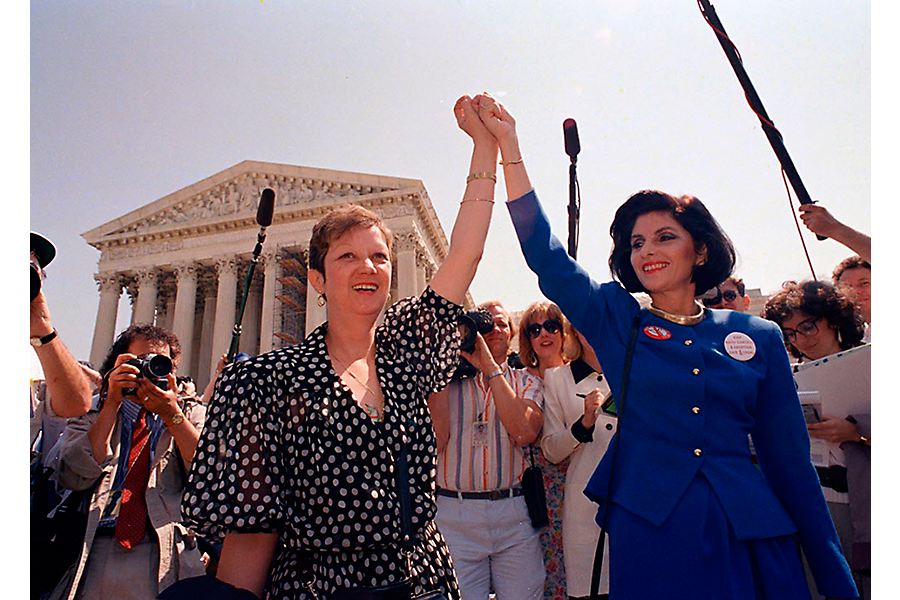How 'Jane Roe' came to symbolize both pro-life and pro-choice
Loading...
You might think Jane Roe from the landmark 1973 Supreme Court case of Roe v. Wade would unhesitatingly support a women’s right to choose.
But the woman behind the pseudonym, whose name was Norma McCorvey and who died on Saturday, had a complicated a relationship with abortion. While she sought the procedure when she was 22, she flipped her stance in 1995 when she first become a born-again Christian.
“I think I have always been pro-life,” Ms. McCorvey once told a local radio station. “I just didn’t know it.”
McCorvey’s death comes at a critical juncture in the abortion debate. While President Trump has promised to overturn the case to give states the right to legislate abortion, the rate of legal abortions in the United States is declining, which researchers attribute to easier access to birth control.
While it seems like the two camps – pro-life vs. pro-choice – remain as split as ever, some studies suggest that like McCorvey’s biography, the abortion debate isn’t that simple.
“We’ve framed our abortion debate all wrong. It isn’t black and white – it’s thousands of different shades of gray that exist somewhere in the middle,” Vox senior editor Sarah Kliff wrote in 2015 after a survey found that almost 2 in 5 Americans identified as neither pro-life nor pro-choice or both.
“By ignoring that gray space, we miss something important: there are abortion policies that a majority of Americans could agree on,” she said.
When McCorvey filed a suit in 1970 against the Dallas County District Attorney, the 22-year-old was not looking to become a nameless symbol of women’s freedom in the United States, as The Washington Post wrote in her obituary. She just wanted the right to legally and safely end a pregnancy she did not wish to carry forward, writes the Post's Emily Langer. But she assumed that mantle soon after the Burger Court ruled 7-2 that a constitutional right to privacy included the choice to terminate a pregnancy.
Until 1995, McCorvey embraced her role as an anti-abortion activist, although she acknowledged that her poor and difficult upbringing made her uneasy around the largely upper-class and well-educated activists she was surrounded by.
In 1994, she had met the Rev. Philip "Flip" Benham, the head of the anti-abortion group Operation Rescue. While she was working at an abortion clinic in Dallas, Operation Rescue set up shop right next door. McCorvey and Rev. Benham butted heads publicly, but they eventually began a friendship. Eventually, McCorvey attended a church service, and later was baptized in a backyard swimming pool.
“Jesus Christ has reached through the abortion-mill wall and touched the heart of Norma McCorvey,” Benham told The Dallas Morning News.
While she eventually converted to Catholicism, McCorvey remained an anti-abortion symbol for the rest of her life.
“Do not vote for Barack Obama,” McCorvey said, according to Vanity Fair. “He murders babies.”
Her about-face embodies some of the complexities of the abortion debate in the United States.
The debate is often framed as a highly polarized face-off between pro-life and pro-choice supporters. A survey by the Pew Research Center in October 2016 found Republicans and Democrats are sharply divided on the issue, with 62 percent of Republicans saying abortions should be illegal in all or most cases, while 79 percent of Democrats believe the exact opposite, that it should be legal in all or most cases.
But the Vox survey from the previous year reveals more nuanced opinions. Careful questioning of more than 1,000 respondents suggests that 21 percent of Americans neither identified as pro-life or pro-choice, while 18 percent identified as both.
This complexity is further evident in another series of questions. When asked whether abortion should be completely illegal or legal, and given various options in between, the largest percentage (34) chose this answer: “Abortion should only be legal in cases of rape, abuse, or if the women’s health is at risk.” And twice as many – nearly 70 percent of respondents – said they would not want a woman to feel ashamed to say if she had an abortion.







